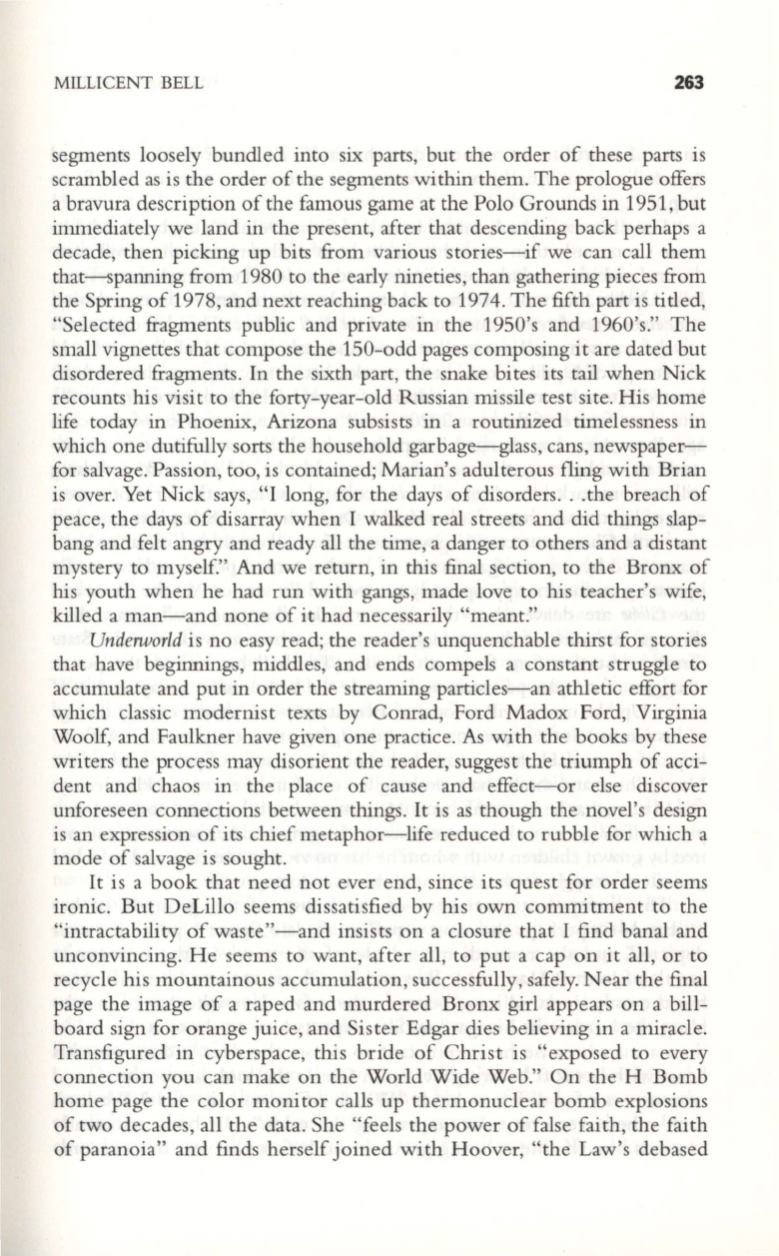
MILLICENT BELL
263
segments loosely bundled into six parts, but the order of these parts is
scrambled as is the order of the segments within them. The prologue offers
a bravura description of the famous game at the Polo Grounds in 1951, but
immediately we land in the present, after that descending back perhaps a
decade, then picking up bits from various stories-if we can call them
that--spanning from 1980 to the early nineties, than gathering pieces from
the Spring of 1978, and next reaching back to 1974. The fifth part is ti tled,
"Selected fragments public and private
in
the 1950's and 1960's." The
small vignettes that compose the 150-odd pages composing it are dated but
disordered fragments. In the sixth part, the snake bites its tail when Nick
recounts his visit to the forty-year-old Russian missile test site. His home
life today in Phoenix, Arizona subsists in a routinized timelessness in
which one dutifully sorts the household garbage-glass, cans, newspaper–
for salvage. Passion, too, is contained; Marian's adulterous fling with Brian
is over. Yet Nick says, "I long, for the days of disorders...the breach of
peace, the days of disarray when I walked real streets and did things slap–
bang and felt angry and ready all the time, a danger to others and a distant
mystery to myself." And we return, in this final section, to the Bronx of
his youth when he had run with gangs, made love to his teacher's wife,
killed a man-and none of it had necessarily "meant."
Underworld
is no easy read; the reader's unquenchable thirst for stories
that have beginnings, middles, and ends compels a constant struggle to
accumulate and put
in
order the streaming particles-an athletic effort for
which classic modernist texts by Conrad, Ford Madox Ford, Virginia
Woolf, and Faulkner have given one practice. As with the books by these
writers the process may disorient the reader, suggest the triumph of acci–
dent and chaos in the place of cause and effect-or else discover
unforeseen connections between things. It is as though the novel's design
is an expression of its chief metaphor-life reduced to rubble for which a
mode of salvage is sought.
It is a book that need not ever end, since its quest for order seems
ironic. But DeLillo seems dissatisfied by his own commitment to the
"intractability of waste"-and insists on a closure that I find banal and
unconvincing. He seems to want, after all, to put a cap on it all, or to
recycle his mountainous accumulation, successfully, safely. Near the final
page the image of a raped and murdered Bronx girl appears on a bill–
board sign for orange juice, and Sister Edgar dies believing in a miracle.
Transfigured in cyberspace, this bride of Christ is "exposed to every
connection you can make on the World Wide Web." On the H Bomb
home page the color monitor calls up thermonuclear bomb explosions
of two decades, all the data. She "feels the power of false faith, the faith
of paranoia" and finds herself joined with Hoover, "the Law's debased


